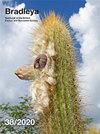标题玻利维亚西北部仙人掌属一新种
IF 1.2
4区 生物学
Q3 PLANT SCIENCES
引用次数: 1
摘要
摘要:描述和说明了玻利维亚西北部的一新种Cumulopuntia (C. flexiispina),它形成具有密集灵活的白色刺的半球形团块。该物种只在海拔4,400米至4,650米之间的高海拔地区被发现。将该新种与其他四种高海拔积云属植物进行了比较,并指出了主要差异:广泛分布的玻利维亚积云属(包括玻利维亚积云亚种);dactylifera),产自秘鲁、玻利维亚和阿根廷;C. glomerata (C. boliviana亚科)在类似的高海拔地区发现,但在更西部的秘鲁、玻利维亚和智利的干旱条件下发现;来自玻利维亚南部和阿根廷北部的紫锥菊,以及来自秘鲁南部和智利北部的紫锥菊。本文章由计算机程序翻译,如有差异,请以英文原文为准。
A new species of Cumulopuntia (Cactaceae) from north-western Bolivia
Summary: A new species of Cumulopuntia (C. flexibilispina) from north-west Bolivia, which forms hemispherical clumps with dense flexible white spination, is described and illustrated. The species is only known from very high elevations between 4,400m and 4,650m. The new species is compared with and key differences are noted from four other high elevation cumulopuntias: the widespread C. boliviana (including C. boliviana subsp. dactylifera) from Peru, Bolivia and Argentina; C. glomerata (C. boliviana subsp. ignescens) which is found at similar high elevations but in more arid conditions further to the west in Peru, Bolivia and Chile; C. chichensis from southern Bolivia and northern Argentina and finally C. echinacea from southern Peru and northern Chile.
求助全文
通过发布文献求助,成功后即可免费获取论文全文。
去求助
来源期刊

Bradleya
PLANT SCIENCES-
CiteScore
2.80
自引率
25.00%
发文量
43
审稿时长
>12 weeks
期刊介绍:
Bradleya is the BCSS contribution to the scientific world and is accepted as such because of its academic standards. It can only flourish with the support of BCSS members, many of whom subscribe to it each year. The aim is to include articles which our members will find interesting and educational, whilst retaining rigorous standards of publication. Scientifically important articles don''t have to be dull to read. So, because Bradleya depends the subscriber, the editor endeavours to make its contents accessible, easily understood and enjoyable for all.
 求助内容:
求助内容: 应助结果提醒方式:
应助结果提醒方式:


